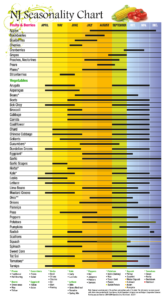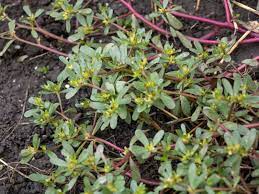WHAT IN TARNATION IS THAT?
When I had my first CSA box in 2006, I remember fruitlessly searching the internet for “green, bulb looking, radish” or “lettuce with plump leaves” and then looking through mountains of images. “Maybe it’s that? It could be that?”
I want to make it easy for you. Here is a list of not so common (and a few common) items and an image (in no particular order) for you to reference. Along with ideas how to use it and my favorite recipe. As always, if you have any questions, please ask! Enjoy!
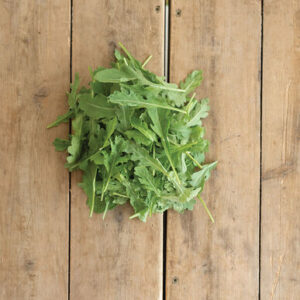
- ARUGULA-can be pungent and spicy. I love this green on pizza (pears, gorgonzola cheese, maybe a honey drizzle?), in salads, and on sandwiches.
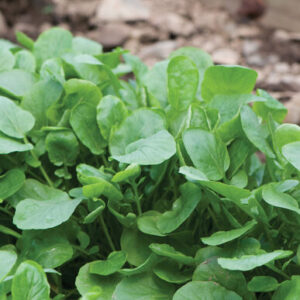
2. UPLAND CRESS-This is basically the same as watercress (just easier for the farmer to grow 😉 ) Cresses are extremely nutritious-with calcium, vitamin k, anti-inflammatory, and phytochemicals (anti-cancer agents). Have upland cress in your salad mix or chop it very fine and sprinkle it on top of fish. It matches well with fish due to it’s slight pepper taste.
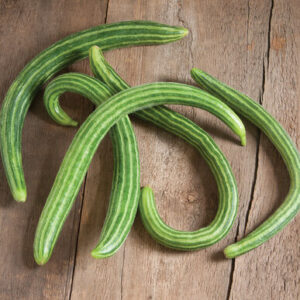
3. STRIPED ARMENIAN CUCUMBER-My FAVORITE cucumber. You don’t need to peel it, it’s RARELY bitter and is crunchy. Perfect!
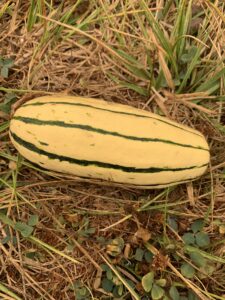
4. DELICATA SQUASH– This is a very easy squash to eat. You don’t need to peel this squash as the skin is very delicate. You can roast it with olive oil and salt or make it sweet with maple syrup or brown sugar. Here is a recipe using many ingredients you’ll find in your CSA box.

5. SUNSHINE KABOCHA SQUASH-Unlike a traditional kabocha, this one can be eaten directly after harvesting. This is my favorite squash due to the sweet buttery and nutty taste. The skin is edible and it’s a matter of preference if you eat it or not. Here’s a link for more detailed info as well as cooking and pairing recommendations.
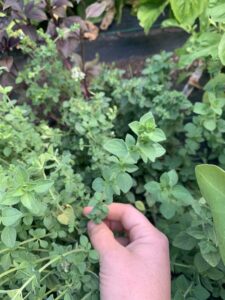
6. MEDITERRANEAN OREGANO-There is two types of oregano, Mexican and Mediterranean. Most of the time in the US, you’ll eat and see Mediterranean oregano. Mediterranean oregano is in the mint family and pairs very well with basil. A great way to use oregano is in a basil oregano pesto. (Maybe zoodle your zucchini and top it off with this recipe.) Pesto can be easily frozen so you can double the recipe for a meal later on.
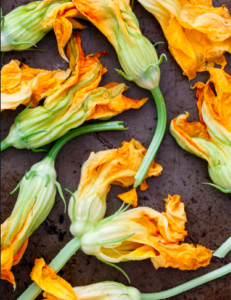
7. ZUCCHINI BLOSSOMS-These nutrient-dense flowers are great raw or cooked. They are very popular in Italian and Mexican cuisine. They are highly perishable and should be used the day of or the next day after you pick up your CSA box. One of the most popular ways to eat them is by stuffing them; however, I grew up eating them in salads. In traditional Italian cuisine, squash blossoms are often stuffed with a mixture of ricotta cheese, Parmesan cheese, and herbs, then dipped in a light batter and pan-fried in oil. Here’s a youtube video showing you how to stuff them.
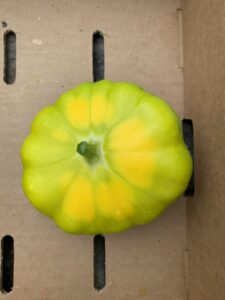
8. PATTY PAN SQUASH-This is a summer squash. You do not have to peel it. They have a buttery, olive oil flavor. You can roast them, saute them, fry them or grill them! They are yellow, green, and sometimes white. Here is a link for 20 best patty pan recipes that I can’t wait to try myself!
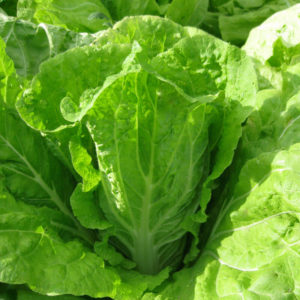
9. NAPA CABBAGE-Sweeter and milder than traditional cabbage, napa cabbage is easy to prepare. Roast large chunks, put it in stir fry or try napa cabbage rolls. Found here.
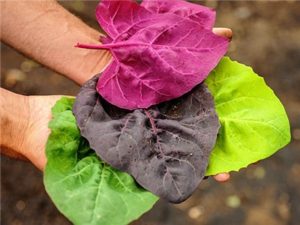
10. ORACH-This year we have purple and green orach from saved seed. It tastes like a mild spinach (and can be used interchangeably). It retains many of the nutrients it pulls up from the soil so it’s exceptionally healthy. Use this spring green in salads or wilt in a skillet with garlic, a little butter and a little salt.
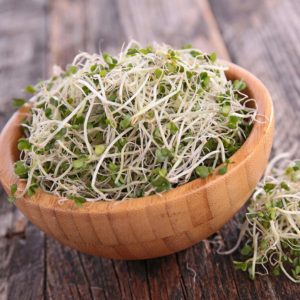
11. MICROGREENS– These are basically little seedlings. They contain more than 5 times the amount of antioxidants than their adult versions. Use them on sandwiches, salads, or in a hummus wrap. Please note: I don’t wash/rinse microgreens before giving them to you because that will drastically shorten their shelf life. Please wash directly before use.
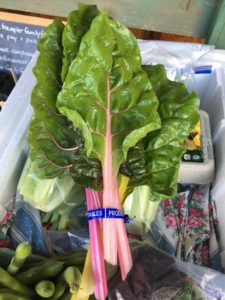
12. SWISS CHARD– You can use the stem and the leaf of swiss chard. The stems can be tough though. Eating it raw or cooked is your preference. Sometimes I eat it raw in salads, but often I will wilt it or sauté it in a skillet. The stem in the middle of the leaf part is often called a rib in recipes. Below is a great recipe.
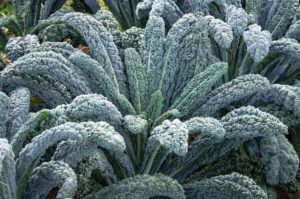
13. BLACK KALE-I have seen black kale labeled as dinosaur kale as well. Confession: I always hated kale until I ate it after it was massaged. Massaging the kale leaves it softer and releases it’s sugars so it’s not so bitter. Directions are in the link below.
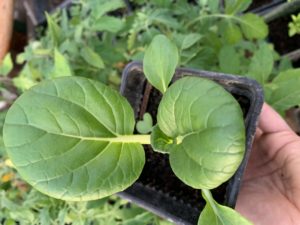
14. PAK CHOI-aka Bok Choy, is a Chinese cabbage. It’s sweet and cooks so quickly! Below is a great recipe.
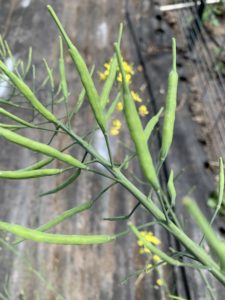
15. PAK CHOI SEED PODS & FLOWERS-The seed pods have a strong pak choi pop of flavor and the flowers (yellow) are sweet. Add to your fresh salads or any sauté mix!
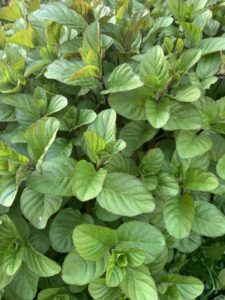
16. CHOCOLATE MINT-The name implies a chocolate taste, but it’s named after it’s coloring. I rinse then rip the leaves up and leave them in a pitcher of water overnight. Then I strain the leaves from the water the next day for a refreshing flavored water. You can also add the leaves to a tea ball infuser and pour hot water over it for mint tea. Of course, there’s mojitos. The recipe is below.
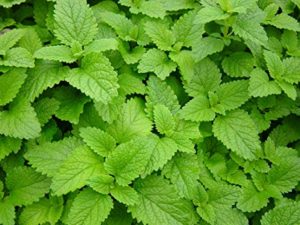
17. LEMON BALM-This is a plant that is part of the mint family, but smells and tastes like lemon. I rinse then rip the leaves up and leave them in a pitcher of water overnight. Then I strain the leaves from the water the next day for a refreshing flavored water. You can also add the leaves to a tea ball infuser and pour hot water over it for lemon tea.
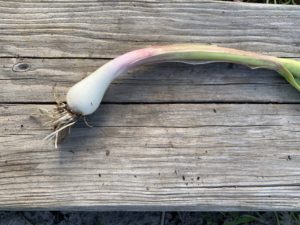
18. GREEN GARLIC-Green garlic is just fresh new garlic that isn’t cured. You can use it however you normally use garlic. For me, that means practically EVERYTHING! 😀
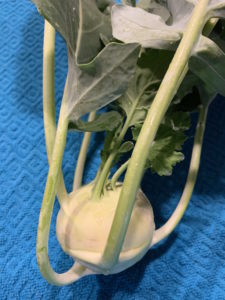

19. KOHLRABI-This is in the same family as cabbage, broccoli, and brussels sprouts. It can be eaten raw or cooked. I, personally, like to eat the greens wilted in a sauté pan with some garlic. I cut the stems down to the bulb and slice the bulb and eat that part raw. The outside skin can be tough so I do skin it. (It’s actually not a bulb or a root, but the stem in this plant becomes bulbous). Below is a recipe for a kohlrabi salad.
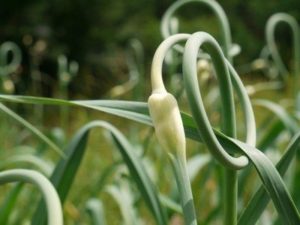
20. GARLIC SCAPES-You can eat the whole scape, including the flowers/flower seeds. It’s like a mild garlic. The scape is the flower stem. Hardneck garlic produces garlic scapes. Below is a link for many ideas on what to do with garlic scapes. I harvest the scapes when there are more straight than curvy for tenderness.
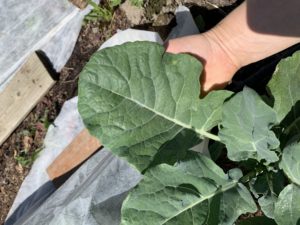
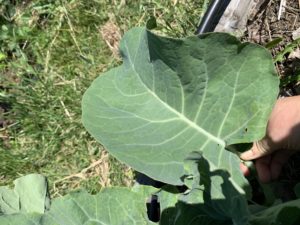
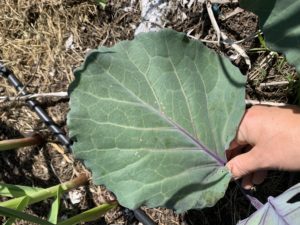
21. LEAFY GREENS-BROCCOLI, CAULIFLOWER AND CABBAGE GREENS-Full of flavor and nutrients, these large greens are easy to chop finely and then sautéed with the garlic scapes or green garlic. Or try them steamed! Their taste is a mild version of the vegetable and grow sweeter when cooked! Below is a link to some other cooking (and juicing!) ideas:
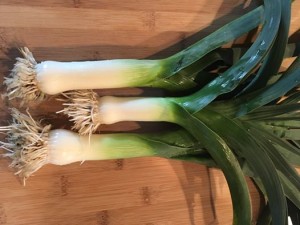
22. LEEKS-Leeks have a mild onion taste. All of the leek is edible, but usually people only use the soft white and light green parts. The dark green part is tough. Leeks go well with potatoes (potatoes leek soup) or use them to flavor other soups, pastas, or dips. Below is a link to my favorite leek recipe.
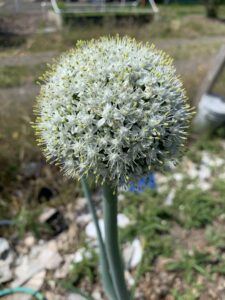
23. Onion Flowers-They taste a lot like chives or green onions and are so pretty! Use them however you would a scallion; roast, salads, sauteed etc
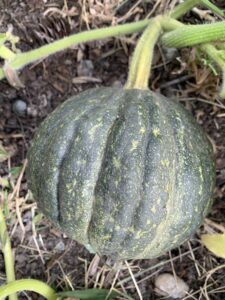
24. Tetsukabuto Squash-bred in Japan and commonly called Tetsu. You can eat it baked, roasted or try this recipe.
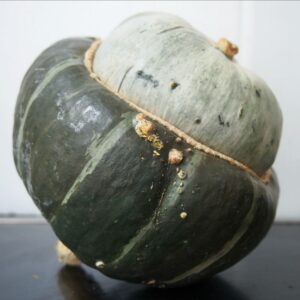
25. Buttercup Squash-sweet and creamy, you can use this to make a cream base for soup or try this maple roasted recipe.
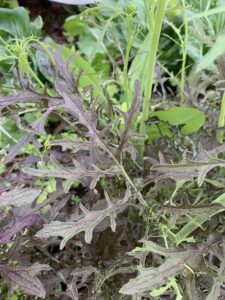
26. Purple Mustard (Mizuna, Japanese Mustard)-is peppery and slightly spicy. It really makes a salad pop or try in your pasta!
27. Purslane-Use purslane anywhere where you’d use spinach. Be careful not to over sautee though to reduce the chance of slimness. (I used it once in zucchini bread when I ran out of zucchini!)
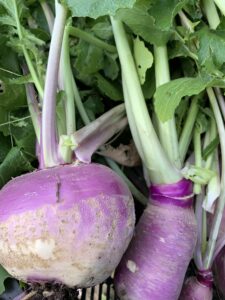
28. Turnips-It looks like a beet but is more related to the mustard family. The leaves are peppery like mustard and taste great wilted with some butter and garlic. The root is incredible roasted and its peppery taste changes to taste more like a sweet potato due to the sugars caramelizing. Here is a roasted turnip recipe.
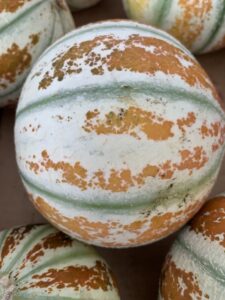
29. Kajari Melon-These are sweet 2lb fruits from India with a similar taste to honeydews.
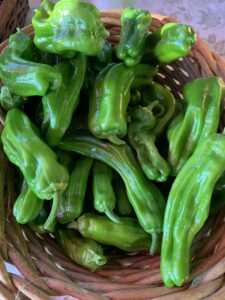
30. Shishito Peppers-These are my favorite peppers. I love them roasted with an aioli sauce. They are usually mild, but every once in a while there’s one with some heat. Here’s a great recipe.
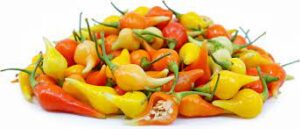
31. Biquinho “Beak” Peppers- These are from Brazil and are mild and fruity. They are great on top of pizzas or you can quick pickle them for a wonderful snack.
I’ll add more as the season continues! Happy Munching!
The chart below was made for NJ, but lines up with our seasons very well:
